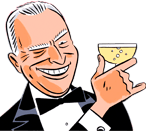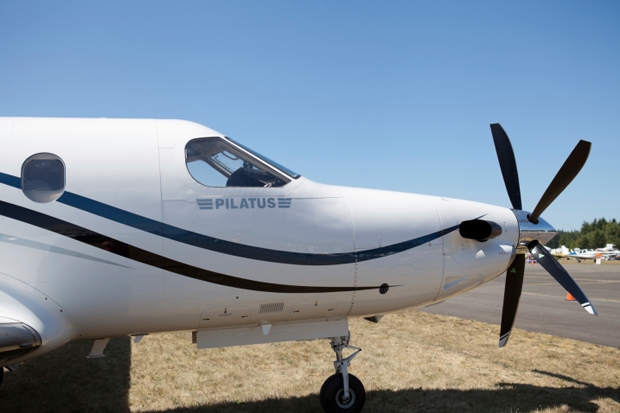This is about life up high. Two weeks ago The Spectator had that rapscallion and mischief-maker Peter McKay writing about how great it is to pilot a plane. (He’s taking lessons and has flown solo.) I’ve always been told that riding a motorcycle and piloting a plane are about the same, and McKay is a motorcyclist. His build, looks and accent are far more suited to riding on two wheels than to piloting a plane (that role is more one for a Cary Grant type). But I am being snobby and writing like McKay — cattily.
Reading about flying brought back pleasant memories, but also a tragic one. When my little girl was 19 and at UCLA (that’s a university in Los Angeles, for any of you unfamiliar with places of higher learning), she informed her mother and me that she wanted to become a pilot. I lost my temper and threatened to cut her off for life, but she went ahead, ignoring my wishes as she always has and always will. Then the big day came for her to fly solo and the mother of my children took my son and flew to El Lay to witness the great event. I met with a Colombian chap up in the Bronx and took to my bed. Everything went fine until, after about 20 minutes, the time came for my daughter to land. As she made her approach, she saw her mother jumping up and down like a crazed teenager in front of Elvis, so she gunned her two-seater and took off again. My son was so embarrassed that he, too, ran off.
Lolly got her certificate and all that, and I was happy she did because coming back to Gstaad from Saint-Tropez about 15 years ago on a private charter I noticed that the pilot was overweight, wheezing and sweating profusely. We were flying over the Alps, it was getting dark, we were being bounced around and he was alone in the cockpit. So I ordered Lolly to fly as co-pilot in case the poor man died at the controls and we ended up crashing on some snowy peak. Everything turned out fine but my little girl did not pursue a flying career after that.
My favourite airplane is a Pilatus, a Swiss-made wonder that can take off and land on a postage stamp. It is a single-engined turbo prop with six or eight seats and standing-up-straight room. A couple of years ago, flying to London on a Pilatus for The Spectator readers’ party, I again hit bad weather over the Alps. Once at Old Queen Street, I asked my Low life buddy Jeremy Clarke if he wanted me to fly him back home so he could impress his rural working-class friends, as he calls them. Jeremy thought it a brilliant idea, but then the deputy editor gave us a very expensive whisky and we both got crocked out of our minds, ending up in some pub nearby. Jeremy, I think, got lucky with some woman who had passed out behind the bar. I went on to Loulou’s and met up with a dizzy blonde who was as sexy as she was unsteady on her Manolos. (Two male friends from The Spectator will confirm this tale.) The next day, flying over the Alps, I felt so awful I almost prayed that we would crash.
I took my first flying lesson at the University of Virginia in the year 1955. I didn’t follow up, but 25 years later the Crawley brothers came down to stay with me at Bruern Abbey, and suggested we learn to fly. There was an airbase nearby, and a flying instructor. Andrew Crawley was a natural, as was Randall, with little me bringing up the rear. But the things that had prevented me from getting a licence back at Virginia — instruments and navigational skills — reared their ugly heads yet again. In September 1987, the brothers rang me and asked if I could call Gianni Agnelli in Turin — I was in an Athens hospital having suffered a heart attack — for an appointment in order to show him some paintings they were selling. I never got through, the boys didn’t wait around and as they took off from one of the worst airports in Europe they crashed and were burned alive. I see their children now and then and we talk about the brothers — two great athletes, incidentally.
McKay writes that as a boy one of his heroes was the fictional aviator Braddock. Mine were real. Two of them, Heinrich zu Sayn-Wittgenstein and Egmont zur Lippe-Weissenfeld, were called the Princes of Darkness because they were both princes as well as Luftwaffe night fighters. Both died in aerial combat, Wittgenstein being the third-highest-scoring ace with 83 wins and 22 night victories. Weissenfeld’s victories amounted to 51. Heinrich had rung up Missie Vassiltchikov two days before he was killed by a British Mosquito fighter and told her how the previous morning he had been to Hitler’s headquarters to receive from ‘our darling’ the Oak Leaves to his Knight’s Cross. His handgun had not been removed so he had a chance to ‘bump him off’. Missie writes in her bestselling Berlin Diaries that the ‘poor boy had no idea he had a day or two left to live’, but was only thinking he should have shot the monster. Along with Günther Rall, Adolf Galland and Hans-Ulrich Rudel, these were heroic warriors and great Germans. It makes one feel ashamed for getting nervous over a little turbulence over the Alps. A major coward, in fact.







Comments